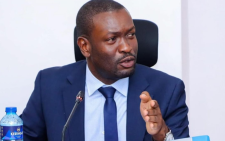Drive to tackle malnutrition in arid Turkana

When Asurut Eperit from Nakapelewoi village in Turkana North constituency delivered her last born son Akiru Edite 18 months ago, the baby was healthy.
But the prolonged drought that is currently ravaging the county has seen most of their livestock die.
As a result, the family has been struggling to get enough food to eat or even clean drinking water. This has caused Akiru’s health to deteriorate.
When we visited their home, we found him sitting on his mother’s lap.
From his small, frail body his tiny ribs were visible. His mother looked worried about her son’s condition, but she was not better either. She could barely stand.
“Before the drought situation worsened, we fed on beef and milk and our health was not compromised. This is no longer available as most of our livestock have died,” said the mother of four.
She added: “We currently rely on boiled maize and rice since this is what is readily available. I cannot remember when last we took a balanced diet as recommended.”
Initially, she thought her son’s health was okay until recently when she visited a local clinic for the 18 months jab.
That is when the nurse in charge told her that the baby was malnourished and was suffering from Moderate Acute Malnutrition (MAM).
He had to be put on nutrition supplements. He was also admitted to the outpatient therapeutic feeding programme that comprises ready to eat therapeutic foods, routine antibiotics and vitamins.
Although at first sight Akiru’s situation looked severe and life threatening, he is now out of danger.
He has been taking the supplements for two weeks. When we visited, his mother had just collected more supplements, hoping that he will fully recover soon.
“My child already likes the food. I am happy because it is not only saving him from pangs of hunger but is also rich in nutrients to prevent him from being malnourished again,” she said.
Full recovery
“I hope that by the time he is done with the 14 packets he will be okay. To facilitate his fully recovery in the shortest time possible I have been adhering to doctors’ advice. I always ensure he takes the supplements without fail and he doesn’t share with his siblings,” Asurut added.
Akiru is not the only child suffering from malnutrition from this constituency.
Gilberto Koki, the Save the Children Operations Lead for Emergency Health East and Southern Africa Region, says there are about 887 children receiving outpatient therapeutic treatment in that constituency and the number keeps on going up.
“People from this constituency have been struggling for survival as severe drought takes hold following three consecutive failed rainy seasons. If no rain comes eventually, the number of malnourished children will go up significantly and this means that more commodities will be needed to facilitate their recovery,” said Koki.
David Lang’at, the nurse-in-charge at Nakapelewoi dispensary, reveals that the region has also started to register cases of Severe Acute Malnutrition (SAM).
Lang’at says during every outreach programme, they admit at least two children with SAM and not less than seven minors with MAM. The outreach programme happens after every two weeks.
“Increased drought in Turkana is contributing to a growing number of malnourished children. To ensure that MAM cases don’t become severe, together with other partners, we have scaled up our emergency nutrition response. We have been taking therapeutic feeds to those affected as well as having outreach clinics in the villages so that we can get those affected on time,” said Koki.
Nutritionist Catherine Locham, says if a child on therapeutic feeds is well taken care of medically and well fed, their recovery journey should take anywhere between four days to one week depending on the severity of the situation.
However, because of the current situation that is forcing hundreds of families to reduce the quantity or quality of the food they eat or both in order to survive, the recovery journey is taking a bit longer.
Locham even revealed that there are instances when they are forced to re-admit some children even after being in the programme for the maximum three-month period.
Besides the children, Koki says they are also bringing on-board expectant and lactating mothers because these are crucial times for both mothers and their children to receive essential nutrients.
He explains that at this stage, women can become stunted in growth and if left unchecked, these issues can be passed on to their newborns.
He explains that under this programme they usually offer Ready-to-Use Therapeutic Food (RUTF) to the affected children. This is an energy-dense, mineral- and vitamin-enriched food that requires no preparation and is specifically designed to treat malnutrition.
Local foods
On the other hand, pregnant and lactating women get enriched or improved porridge flour made with nutritious local foods. “For every outreach clinic we offer children under this programme 14 sachets of RUFT. However, if after seven days there is no improvement we summon the child to check if there are other underlying conditions,” said Langat.
Koki reveals it is the national government and other partners that offer the RUFT.
All they do as an organisation is to facilitate health facilities with funding from the Office of US Foreign Disaster Assistance to take their services closer to the people through outreach clinics/centers.
“We realised that local dispensaries are located far away from homes. To bridge the gap, we decided to be supporting those outreach programmes to take the services closer to the people and ensure the commodities benefit as many people as possible,” he said.













